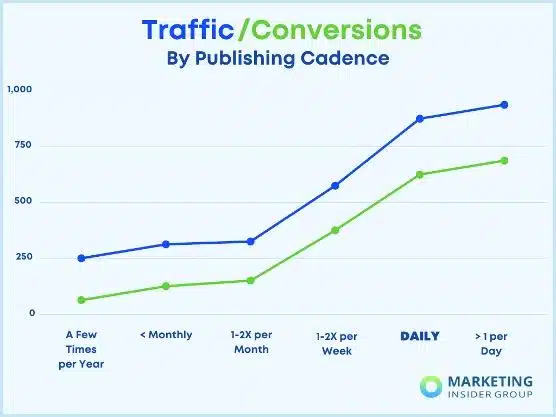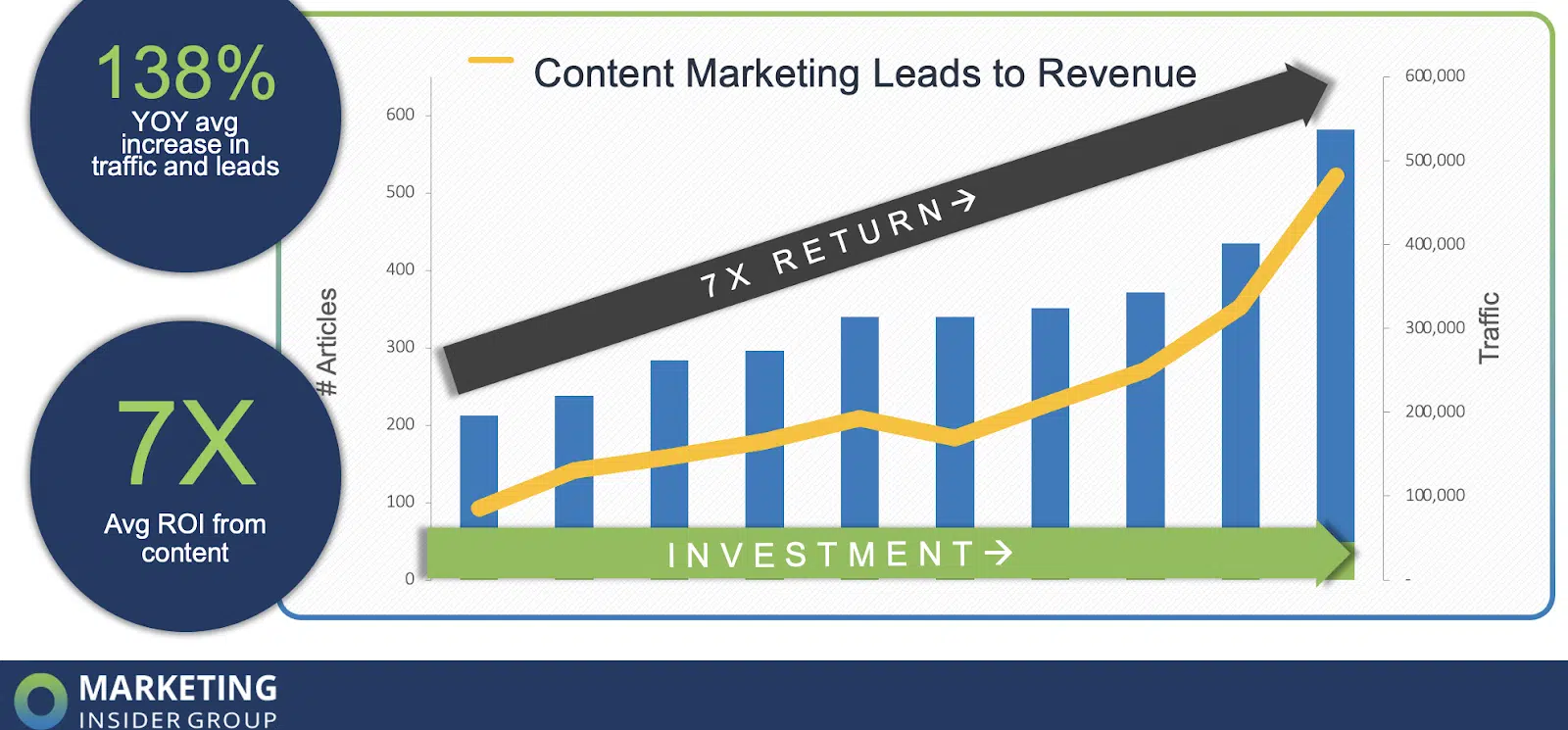The importance of a well-structured blog posting schedule cannot be underestimated. When done right, it can enhance audience engagement and maximize the impact of your content. Find out how to optimize your posting schedule with the following case studies and best practices.
Key takeaways:
- Optimizing your blog posting schedule can boost SEO and audience engagement
- When determining blog posting frequency, analyze audience behavior, preferences and peak traffic times.
- Balancing consistency and evergreen content is key.
- Don’t sacrifice content quality for quantity.
Why a blog posting schedule matters
The success of your blog heavily relies on a carefully thought-out schedule for posting. By defining when and how often you’ll publish content, you can efficiently plan and organize your writing process, saving time and reducing stress in the long run. The schedule ensures that your blog remains current and relevant, fostering consistency that attracts and retains a loyal following.
Also, a well-maintained blogging schedule can significantly boost your search engine optimization (SEO) efforts since search engines reward sites with fresh and regularly published content.
Blogs often serve as the foundation for maintaining that consistency and play a vital role in attracting new clients. They also give you the opportunity to address daily queries and concerns that clients may have.
However, the burning question remains: How often should you blog to achieve optimal results? We have discovered a compelling answer that may hold the key to success for content marketers.
We looked at multiple studies and real-world client experiences in various B2B, B2C and ecommerce domains and found the magic number for blog post frequency: 2-4 times a week.

This frequency results in increased website traffic and yields higher conversion rates, making it an ideal sweet spot for ongoing content marketing success.

As a rule of thumb, higher blogging frequency tends to attract more traffic. Companies that publish four blog posts per week or more witness 3.5 times the traffic compared to those posting less than once a week. Blogging consistently can also significantly impact audience engagement and business growth.
The data we found portrays a strong correlation to support that consistency is crucial in content marketing. In light of these findings, content marketers are encouraged to start their blogging journey with 1-2 high-quality articles published weekly. Over time, this consistent and diligent approach will likely yield substantial positive changes in website traffic, lead generation and overall audience engagement.
Analyzing your target audience
When determining your blog posting frequency, relying on data-driven decisions is necessary for reaching your target audience. Data-driven decisions involve closely monitoring behavior, preferences and peak traffic times, then tailoring your blogging strategy accordingly.
Start by diving into your analytics to gain insights to learn from. Sketch out buyer personas and use content analytics to discover demographics, pain points, preferred channels and time spent online.
You can also use social media to paint a portrait of your target customer segments. This will help you understand their needs and align your content strategy with their preferences. By gathering information on how often they read your posts and what topics interest them the most, you can fine-tune your publishing content and frequency to cater to their expectations.
Remember, creating a schedule you can sustain without compromising content quality is essential. High-quality content with a lower posting frequency will always resonate with audiences more than a higher volume of low-quality content.
Another critical aspect of data-driven decisions is the freshness of content and how that impacts search engine rankings. Google’s Query Deserves Freshness (QDF) ranking factor prioritizes newly published pages, especially for news-oriented websites.
Relying on data-driven decisions will help you create a blogging strategy that aligns with your business goals, attracts the right audience and fosters brand awareness and loyalty in today’s competitive digital landscape. By analyzing data and gaining insights into your audience’s online behavior, you can make informed decisions for your blog.
Factors influencing blog posting frequency
A few things should always be considered when creating your blogging schedule to ensure it aligns with your content goals.
Content type and depth
Content type and depth play huge roles in content creation and its influence on the target audience. Understanding the context in which information will be used and tailoring content to meet the audience’s specific needs directly drive success in any marketing strategy.
Content type
The type of content you produce influences how effectively you can engage and connect with your audience. Content can serve various purposes and include blog posts, emails, social media content, guides, ebooks, video content, webinars, case studies, white papers, press releases, infographics, tutorials, podcasts and more.
Each content type has a specific structure that helps audiences know what to expect. For example, a case study typically includes case descriptions, goals, steps taken and results, making it suitable for the B2B community.
Content depth
Content depth refers to the level of detail and insight provided in a piece of content. In B2B marketing, subjects can be esoteric or technical, meaning creating relevant and engaging content requires understanding the context for content consumption. The secret to writing good B2B content lies in knowing your context.
Context
Context in content refers to everything that surrounds the main topic and it is what makes a subject interesting and compelling to the audience. For instance, if you are writing about data encryption, it’s not enough to present entry-level facts about encryption. Understanding your audience’s worries, interests and what excites them will help you develop context that draws them into your material.
You can leverage the Theory of Mind (ToM) approach, which allows you to understand how your audience perceives and reacts to the subject matter, enabling you to create context that resonates with them.
By aligning content depth with your audience’s specific needs and interests, you can craft content that educates and captivates, driving further action.
Best practices for blog posting frequency
While there is no one-size-fits-all approach to blog posting frequency, we have compiled a few standout practices that can help guide your decision-making process:
Analyze audience behavior and preferences
Understanding your target audience’s behavior and preferences is key to determining the right posting frequency. Analyze metrics such as website traffic, user engagement and bounce rates to identify patterns in audience activity.
This data can help you gauge how often your audience wants to receive new content and what types of posts they find most intriguing.
Quality over quantity
While posting frequently is beneficial for organic traffic and SEO, quality should never be sacrificed for quantity. Focus on producing high-quality, valuable content that resonates with your audience. Consistently delivering valuable insights and information will foster trust and loyalty among your readers, leading to better long-term results.
Be consistent
Establish a regular posting schedule and stick to it. Consistency helps build anticipation among your audience and keeps them coming back for more. Whether you post daily, weekly, or bi-weekly, maintaining a predictable schedule lets your readers know when to expect new content.
Consider your resources
The frequency of your blog posts should align with your available resources. If you have a small team or limited time, publishing multiple posts daily might not be feasible. Be realistic about what you can manage effectively without compromising the quality of your content.
Experiment and analyze
Blog posting frequency is not set in stone. Experiment with different frequencies and track your results. Analyze the impact it has on website traffic, engagement and conversion rates.
Based on the data, refine your posting frequency to find the sweet spot that yields the best results for your specific audience and goals.
Understand the purpose of your blog
The posting frequency should align with the values, goals and standards of your blog. More frequent posting may be necessary if your primary objective is to drive organic traffic. On the other hand, if your focus is on in-depth, research-driven articles, a less frequent but high-quality approach may be more suitable.
By following these guidelines and adapting to your audience’s needs, you can maintain an engaging and successful blog that suits and supports your business goals.
Technology can help create your blog calendar
Content planning tools can help make this process ten times easier when creating a blog schedule or calendar. We use a platform called DivvyHQ to manage all the weekly content calendars for more than a dozen writers across over two dozen clients.
Comprehensive content calendar software is designed to help teams visualize, organize and communicate their editorial plans effectively. It is particularly beneficial for content marketing organizations, as it helps to sort out and organize future deliverables.
This can be particularly beneficial for enterprise and global organizations with multiple channels and business units operating across different time zones.
By leveraging all the advanced features of today’s technology-driven world, content creators and marketing teams can create an effective and organized blog schedule, allowing them to deliver high-quality content consistently to their audience.
Get MarTech! Daily. Free. In your inbox.
Opinions expressed in this article are those of the guest author and not necessarily MarTech. Staff authors are listed here.
























































![Key Metrics for Social Media Marketing [Infographic] Key Metrics for Social Media Marketing [Infographic]](https://www.socialmediatoday.com/imgproxy/nP1lliSbrTbUmhFV6RdAz9qJZFvsstq3IG6orLUMMls/g:ce/rs:fit:770:435/bG9jYWw6Ly8vZGl2ZWltYWdlL3NvY2lhbF9tZWRpYV9yb2lfaW5vZ3JhcGhpYzIucG5n.webp)
















